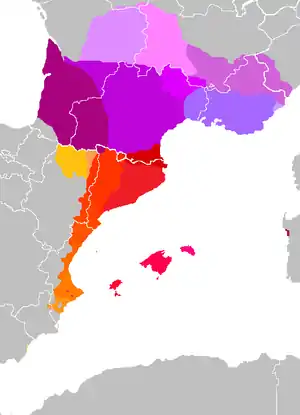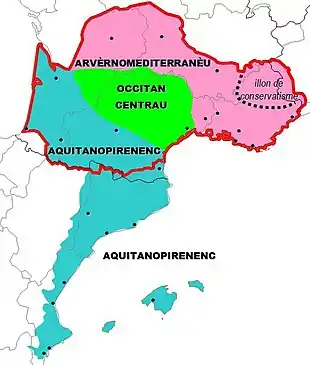Occitano-Romance languages
The Occitano-Romance or Gallo-Narbonnese (Catalan: llengües occitanoromàniques, Occitan: lengas occitanoromanicas, Aragonese: lenguas/llenguas occitanorománicas), or rarely East Iberian,[1] is a branch of the Romance language group that encompasses the Catalan/Valencian, Occitan languages and Aragonese spoken in parts of southern France and northeastern Spain.[2][3]
| Occitano-Romance | |
|---|---|
| Narbonensis dialect | |
| Geographic distribution | France, Spain, Andorra, Monaco, Italy |
| Linguistic classification | Indo-European
|
| Subdivisions | |
| Glottolog | None |
 Occitano-Romance languages and dialects
| |
Extent
The group covers the languages of the southern part of France (Occitania including Northern Catalonia), eastern Spain (Catalonia, Valencian Community, Balearic Islands, La Franja, Carche, Northern Aragon), together with Andorra, Monaco, parts of Italy (Occitan Valleys, Alghero, Guardia Piemontese), and historically in the County of Tripoli and the possessions of the Crown of Aragon. The existence of this group of languages is discussed on both linguistic and political bases.
Classification of Catalan
According to some linguists both Occitan and Catalan/Valencian should be considered Gallo-Romance languages. Other linguists concur as regarding Occitan but consider Catalan and Aragonese to be part of the Ibero-Romance languages.
The issue at debate is as political as it is linguistic because the division into Gallo-Romance and Ibero-Romance languages stems from the current nation states of France and Spain and so is based more on territorial criteria than historic and linguistic criteria. One of the main proponents of the unity of the languages of the Iberian Peninsula was Spanish philologist Ramón Menéndez Pidal, and for a long time, others such as Swiss linguist Wilhelm Meyer-Lübke (Das Katalanische, Heidelberg, 1925) have supported the kinship of Occitan and Catalan. Moreover, the fact that Aragonese hasn't been studied as much as both Catalan and Occitan, many people label it as a Spanish dialect.[4]
From the 8th century to the 13th century, there was no clear linguistic distinction between Occitania and Catalonia. For instance, the Provençal troubadour, Albertet de Sestaró, says: "Monks, tell me which according to your knowledge are better: the French or the Catalans? and here I shall put Gascony, Provence, Limousin, Auvergne and Viennois while there shall be the land of the two kings."[5] In Marseille, a typical Provençal song is called 'Catalan song'.[6]
Internal variation
Most linguists separate Catalan and Occitan, but both languages have been treated as one in studies by Occitan linguists attempting to classify the dialects of Occitan in supradialectal groups, such is the case of Pierre Bec[7] and, more recently, of Domergue Sumien.[8]
 Supradialectal classification of Occitano-Romance according to P. Bec
Supradialectal classification of Occitano-Romance according to P. Bec Supradialectal classification of Occitano-Romance according to D. Sumien
Supradialectal classification of Occitano-Romance according to D. Sumien
Both join together in an Aquitano-Pyrenean or Pre-Iberian group including Catalan, Gascon and a part of Languedocian, leaving the rest of Occitan in one (Sumien: Arverno-Mediterranean) or two groups (Bec: Arverno-Mediterranean, Central Occitan
The answer to the question of whether Gascon or Catalan should be considered dialects of Occitan or separate languages has long been a matter of opinion or convention, rather than based on scientific ground. However, two recent studies support Gascon's being considered a distinct language. For the very first time, a quantifiable, statistics-based approach was applied by Stephan Koppelberg in attempt to solve this issue.[9] Based on the results he obtained, he concludes that Catalan, Occitan, and Gascon should all be considered three distinct languages. More recently, Y. Greub and J.P. Chambon (Sorbonne University, Paris) demonstrated that the formation of Proto-Gascon was already complete at the eve of the 7th century, whereas Proto-Occitan was not yet formed at that time.[10] These results induced linguists to do away with the conventional classification of Gascon, favoring the "distinct language" alternative. Both studies supported the early intuition of late Kurt Baldinger, a specialist of both medieval Occitan and medieval Gascon, who recommended that Occitan and Gascon be classified as separate languages.[11][12]
Linguistic variation
Similarities between Catalan, Occitan and Aragonese
- Both Varieties of Catalan and Occitan have apocope on terminal latin vowels -Ĕ, -Ŭ (later -e, -o):
Latin Catalan Occitan Spanish Orthography IPA Orthography IPA Orthography IPA TRÚNCU(M) [ˈt̪rʊŋ.kʊ̃ˑ] tronc [tɾoŋ(k)] tronc [tɾoŋ(k)] tronco LIGNṒSU(M) [lʲɪŋˈn̪oː.sʊ̃ˑ] llenyós [ʎəˈɲos] lenhós [leˈɲus] leñoso
- This evolution does not occur when the ellision of -e or -o results in a terminal consonant cluster.
Latin Old Occitan Catalan Occitan ÁRBORE(M) ARBRE arbre arbre QUÁTTOR QUÁTRO quatre quatre
- A large part of the lexicon is shared, and in general written words in Catalan and Occitan are mutually intelligible. Similar to the differences in lexicon between Portuguese and Spanish (although this is not always the case with spoken language and varies from dialect to dialect). There are also notable cognates between Catalan, Valencian, Occitan and Aragonese.
English Latin Occitan Catalan Aragonese old VÉCLA(M) vielha vella viella middle / half MÉDIU(M) mièg mig meyo I ÉGO ieu ~ jo jo yo to follow SÉQUERE seguir ~ siegere seguir seguir(e) leaf FÓLIA(M) fuòlha ~ fuèlha fulla fuella ~ folla
Differences between Catalan and Occitan
Most of the differences of the vowel system stem from neutralizations that take place on unstressed syllables. In both languages a stressed syllable has a great number of possible different vowels, while phonologically different vowels end up being articulated in the same way in an unstressed syllable. Although this neutralization is common to both languages, the details of the differ markedly. In Occitan the form of neutralization depends on whether a vowel is pretonic (before the stressed syllable) or postonic (after the stressed syllable). For example /ɔ/ articulates as [u] in pretonic position and as [o] in postonic position, and only as [ɔ] in stressed position. In contrast neutralization in Catalan is the same regardless of the position of the unstressed syllable (although it differs from dialect to dialect). Many of these changes happened in the 14th or late 13th century.
Slightly older are the palatalizations present in Occitan before a palatal or velar consonant:
| Occitan | Catalan | English |
|---|---|---|
| vielha | vella | Old |
| mièg | mig | Middle/Half |
| ieu/jo | jo | I |
| seguir | seguir | To follow |
| fuèlha | fulla | Leaf |
Lexical comparison
Variations in the spellings and pronunciations of numbers in several Occitano-Romance dialects:[13][14]
Numeral Occitan Catalan Aragonese[15] PROTO-
OcRmNorthern Occitan Western Occitan Eastern Occitan Eastern Catalan Northwestern Catalan Auvergnat Limousin Gascon Languedocien Provençal 1 vyn / vynɐ
vun / vunåỹ / ynɔ
un / unay / yo
un / uaỹ / yno
un / unayŋ / yno
un / unaun / unə
un / unaun / una
un / unaun~uno / una
un~uno / una*un / *una 2 du / dua
dou / duasdu / dua
dos / doasdys / dyos
dus / duasdus / duos
dos / doasdus / duas
dous / douasdos / duəs
dos / duesdos
dos / duesdos / duas
dos / duas*dos~dus / *duas 3 tʀei
treitrei
trestres
trestres
trestʀes
trestrɛs
trestrɛs
trestɾes
tres*tres 4 katʀə
catrekatre
quatrekwatə
quatrekatre
quatrekatʀə
quatrekwatrə
quatrekwatre
quatrekwatro~kwatre
quatro / quatre*kwatre 5 ʃin
sinʃin
cincsiŋk
cinqsiŋk
cinqsiŋ
cinqsiŋ / siŋk
cincsiŋ / siŋk
cincθiŋko~θiŋk
cinco / cinc*siŋk 6 ʃei
sieiʃiei
sieisʃeis
sheissiɛis
sièissiei
sieissis
sissis
sisseis~sieis
seis / sieis*sieis 7 se
séʃe
sètsɛt
sètsɛt
sètsɛ
sètsɛt
setsɛt
setsiet~sɛt
siet / set*sɛt 8 vø
veujɥe
uèchweit
ueitɥet͡ʃ
uèchvɥe
vuebuit / vuit
vuitvuit / wit
vuit / huitweito~weit
ueito / ueit*weit 9 niø~nou
nieu~nounɔu
nòunau
naunɔu
nòunu
nòunɔu
nounɔu
nounweu~nɔu
nueu / nou*nɔu 10 die~de
dié~dédiɛ~de
detzdɛt͡s
dètzdɛt͡s
dètsdɛs
dèsdɛu
deudɛu
deudieθ~deu
diez / deu*dɛt͡s
The numbers 1 and 2 have both feminine and masculine forms agreeing with the object they modify.
References
- "Ibero-Romance". Retrieved 4 October 2017.
- "Mas se confrontam los parlars naturals de Catalonha e d'Occitania, i a pas cap de dobte, em en preséncia de parlars d'una meteissa familha linguistica, la qu'ai qualificada d'occitano-romana, plaçada a egala distància entre lo francés e l'espanhòl." Loís Alibèrt, Òc, n°7 (01/1950), p. 26
- Lozano Sierra J, Saludas Bernad A.. Aspectos morfosintácticos del Belsetán. Saragossa: Gara d'Edizions, 2007, p. 180. ISBN 84-8094-056-5.
- Tomás Arias, Javier. Elementos de lingüística contrastiva en aragonés: estudio de algunas afinidades con gascón, catalán y otros romances (Thesis). Universitat de Barcelona, 2016-07-08
- Monges, causetz, segons vostre siensa qual valon mais, catalan ho francés?/ E met de sai Guascuenha e Proensa/ E lemozí, alvernh’ e vianés/ E de lai met la terra dels dos reis.
- Manuel Milá y Fontanals (1861). De los trovadores en España: Estudio de lengua y poesía provenzal. J. Verdaguer. p. 14.
- Pierre BEC (1973), Manuel pratique d’occitan moderne, coll. Connaissance des langues, Paris: Picard
- Domergue SUMIEN (2006), La standardisation pluricentrique de l'occitan: nouvel enjeu sociolinguistique, développement du lexique et de la morphologie, coll. Publications de l'Association Internationale d'Études Occitanes, Turnhout: Brepols
- Stephan Koppelberg, El lèxic hereditari caracteristic de l'occità i del gascó i la seva relació amb el del català (conclusions d'un analisi estadística), Actes del vuitè Col·loqui Internacional de Llengua i Literatura Catalana, Volume 1 (1988). Antoni M. Badia Margarit & Michel Camprubi ed. (in Catalan)
- Chambon, Jean-Pierre; Greub, Yan (2002). "Note sur l'âge du (proto)gascon". Revue de Linguistique Romane (in French). 66: 473–495.
- Baldinger, Kurt (1962). "La langue des documents en ancien gascon". Revue de Linguistique Romane (in French). 26: 331–347.
- Baldinger, Kurt (1962). "Textes anciens gascons". Revue de Linguistique Romane (in French). 26: 348–362.
- "Indo-European numerals (Eugene Chan)". Archived from the original on 2012-02-12. Retrieved 2019-05-15.
- Cardinals en l'argonés
- "Los números en aragonés: Cardinales". Archived from the original on 2019-04-21. Retrieved 2019-05-15.CS1 maint: bot: original URL status unknown (link)